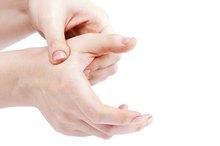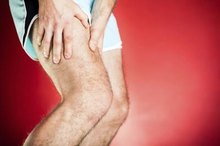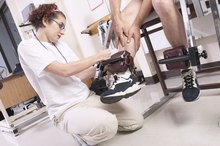Facts on Heel of Hand Pain
Heel of hand pain is more common on the side of the thumb. It usually stems for an overuse of the hands through repetitive motions such as typing or factory work. A person with heel of hand pain may want to get a proper diagnosis of the condition. The source of the pain can be caused by several conditions. Treatment varies but usually includes a combination of rest, ice, medication and exercise.
If you are experiencing serious medical symptoms, seek emergency treatment immediately.
Identification
Heel of hand pain can stem from a bruise, strain, tendinitis, arthritis or De Quervain's tenosynovitis syndrome 1. A person with carpal tunnel syndrome may also experience pain in this area. People with arthritis and tenosynovitis usually have aching between the wrist and base of the thumb 1. There may be swelling in the heel of the hand as well. Either condition can cause a weakness in the surrounding muscle tissue. People may have trouble gripping objects or even using their hand for basic tasks. A doctor may need to prescribe an X-ray or other test to correctly identify the problem.
- Heel of hand pain can stem from a bruise, strain, tendinitis, arthritis or De Quervain's tenosynovitis syndrome 1.
- People may have trouble gripping objects or even using their hand for basic tasks.
Effects of Rest, Ice and Heat
Hand Tendon Exercises
Learn More
Most heel of hand pain such as tendinitis requires a certain period of rest 1. This can prevent further aggravation of the injury or condition. It also gives the ice time to reduce inflammation and consequential pain. Ice can relieve heel of hand pain by restricting blood vessels (vasoconstriction) and, thus, the flow of blood and lymph fluid to the area. Ice is most effective if used at 20-minute intervals throughout the day. Elevating the hand above the heart can also reduce swelling. After a couple days, heat can promote blood (with its healing properties) flow to the heel of the hand.
Types of Medications
Most heel of hand pain can be treated with anti-inflammatory medications such as ibuprofen and naproxen. These medicines control inflammation and pain by reducing the effects of Cox-2 enzymes and prostaglandins (chemicals), which are produced as a natural body reaction to an injury. Certain topical creams may also be effective for heel of hand pain. Steroids may be used for more severe pain in the heel of hand area.
- Most heel of hand pain can be treated with anti-inflammatory medications such as ibuprofen and naproxen.
- Steroids may be used for more severe pain in the heel of hand area.
Types of Exercise
Forearm & Hand Pain
Learn More
Once swelling and pain are somewhat under control, stretching and strength-building exercises can alleviate heel of hand pain. Squeezing a tennis ball can build strength in the hand and promote blood flow to the affected area. Stretching the thumb back or rotating it can help rebuild mobility in this appendage and loosen up tight joints, ligaments and hand muscles. Exercises can also be performed for rehabilitation after surgery. According to Dr. Nathan Wei, a nationally known rheumatologist, "strength recovery may take up to one year depending on the amount of weakness prior to surgery and how vigorously strengthening exercises are continued."
- Once swelling and pain are somewhat under control, stretching and strength-building exercises can alleviate heel of hand pain.
Time Frame
There is no set time frame for overcoming heel of hand pain. Some conditions may be more chronic or require surgery. Nevertheless, individuals who get their condition properly diagnosed and follow a specific treatment regimen usually recover more quickly from heel of hand pain.
Related Articles
References
- Hand Tendinitis And Tenosynovitis
- Tu P, Bytomski JR. Diagnosis of heel pain. Am Fam Physician. 2011;84(8):909-16.
- Lim AT, How CH, Tan B. Management of plantar fasciitis in the outpatient setting. Singapore Med J. 2016;57(4):168-70. doi:10.11622/smedj.2016069
- Li HY, Hua YH. Achilles Tendinopathy: Current Concepts about the Basic Science and Clinical Treatments. Biomed Res Int. 2016;2016:6492597. doi:10.1155/2016/6492597
- Gulati V, Jaggard M, Al-nammari SS, et al. Management of achilles tendon injury: A current concepts systematic review. World J Orthop. 2015;6(4):380-6. doi:10.5312/wjo.v6.i4.380
- Hong CH, Lee YK, Won SH, Lee DW, Moon SI, Kim WJ. Tarsal tunnel syndrome caused by an uncommon ossicle of the talus: A case report. Medicine (Baltimore). 2018;97(25):e11008. doi:10.1097/MD.0000000000011008
- Mayer SW, Joyner PW, Almekinders LC, Parekh SG. Stress fractures of the foot and ankle in athletes. Sports Health. 2014;6(6):481-91. doi:10.1177/1941738113486588
- Tu P. Heel Pain: Diagnosis and Management. Am Fam Physician. 2018;97(2):86-93.
- Yi TI, Lee GE, Seo IS, Huh WS, Yoon TH, Kim BR. Clinical characteristics of the causes of plantar heel pain. Ann Rehabil Med. 2011;35(4):507-13. doi:10.5535/arm.2011.35.4.507
- Kucuksen S, Karahan AY, Erol K. Haglund syndrome with pump bump. Med Arch. 2012;66(6):425-7.
- Vaishya R, Agarwal AK, Azizi AT, Vijay V. Haglund's Syndrome: A Commonly Seen Mysterious Condition. Cureus. 2016;8(10):e820. doi:10.7759/cureus.820
- Pękala PA, Henry BM, Pękala JR, Piska K, Tomaszewski KA. The Achilles tendon and the retrocalcaneal bursa: An anatomical and radiological study. Bone Joint Res. 2017;6(7):446-451. doi:10.1302/2046-3758.67.BJR-2016-0340.R1
- Helgeson K. Examination and intervention for sinus tarsi syndrome. N Am J Sports Phys Ther. 2009;4(1):29-37.
- Ma DL, Vano-galvan S. Piezogenic pedal papules. CMAJ. 2013;185(18):E847. doi:10.1503/cmaj.121963
- Fritz JM, Mcdonald JR. Osteomyelitis: approach to diagnosis and treatment. Phys Sportsmed. 2008;36(1):nihpa116823. doi:10.3810/psm.2008.12.11
- Yan L, Zong J, Chu J, et al. Primary tumours of the calcaneus. Oncol Lett. 2018;15(6):8901-8914. doi:10.3892/ol.2018.8487
- Narváez JA, Narváez J, Ortega R, Aguilera C, Sánchez A, Andía E. Painful heel: MR imaging findings. Radiographics. 2000;20(2):333-52. doi:10.1148/radiographics.20.2.g00mc09333
- Thomas JL, Christensen JC, Kravitz SR, et al. The diagnosis and treatment of heel pain: a clinical practice guideline-revision 2010. J Foot Ankle Surg. 2010;49(3 Suppl):S1-19. doi:10.1053/j.jfas.2010.01.001
- Noor S, Khan RU, Ahmad J. Understanding Diabetic Foot Infection and its Management. Diabetes Metab Syndr. 2017;11(2):149-156. doi:10.1016/j.dsx.2016.06.023
- Lui E. Systemic causes of heel pain. Clin Podiatr Med Surg. 2010;27(3):431-41. doi:10.1016/j.cpm.2010.04.004
- Podolsky R, Kalichman L. Taping for plantar fasciitis. J Back Musculoskelet Rehabil. 2015;28(1):1-6. doi:10.3233/BMR-140485
- Habets B, Van cingel REH, Backx FJG, Huisstede BMA. Alfredson versus Silbernagel exercise therapy in chronic midportion Achilles tendinopathy: study protocol for a randomized controlled trial. BMC Musculoskelet Disord. 2017;18(1):296. doi:10.1186/s12891-017-1656-4
- Riskowski J, Dufour AB, Hannan MT. Arthritis, foot pain and shoe wear: current musculoskeletal research on feet. Curr Opin Rheumatol. 2011;23(2):148-55. doi:10.1097/BOR.0b013e3283422cf5
- Donley BG, Moore T, Sferra J, Gozdanovic J, Smith R. The efficacy of oral nonsteroidal anti-inflammatory medication (NSAID) in the treatment of plantar fasciitis: a randomized, prospective, placebo-controlled study. Foot Ankle Int. 2007;28(1):20-3. doi:10.3113/FAI.2007.0004
- Sahu RL. Percutaneous planter fasciitis release under local anesthesia: A prospective study. Chin J Traumatol. 2017;20(2):87-89. doi:10.1016/j.cjtee.2017.01.002
- American Academy of Orthopedic Surgeons. (2017). Heel Pain. https://orthoinfo.aaos.org/en/diseases--conditions/heel-pain
- Buchbinder R. (2018). Patient education: Heel and foot pain (caused by plantar fasciitis) (Beyond the Basics). Isaac Z, ed. UpToDate. Waltham, MA: UpToDate Inc.
- Lareau CR, Sawyer G, Wang JH, DiGiovanni CW. Plantar and medial heel pain: diagnosis and management. J Am Acad Orthop Surg. 2014 Jun;22(6):372-80. doi: 10.5435/JAAOS-22-06-372
- Ma DL, Vano-Galvan S. Piezogenic pedal papules. CMAJ. 2013 Dec 10;185(18):E847. doi: 10.1503/cmaj.121963
- Tu P, Bytomski JR. Diagnosis of Heel Pain. Am Fam Physician. 2011 Oct 15;84(8):909-16. https://www.aafp.org/afp/2011/1015/p909.html
- Vaishya R, Agarwal AK, Azizi AT, Vijay V. Haglund's Syndrome: A Commonly Seen Mysterious Condition. Cureus. 2016 Oct;8(10):e820. doi: 10.7759/cureus.820









